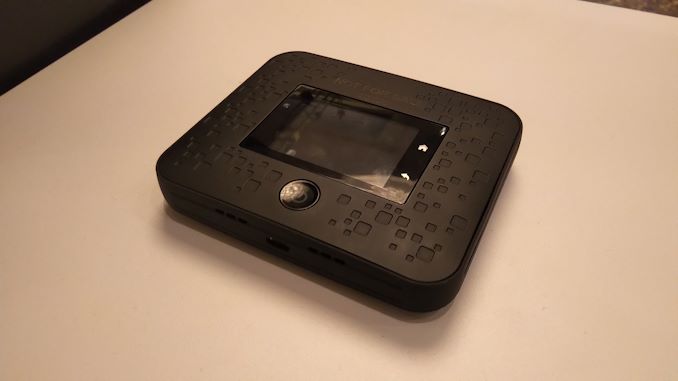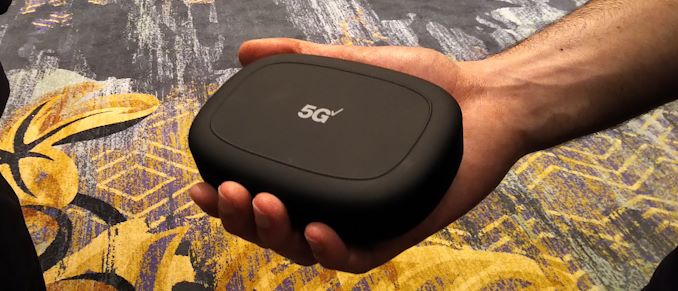5G Mobile Hotspots: Netgear for AT&T and inseego for Verizon
by Ian Cutress on December 10, 2018 5:00 PM EST
Most of the 5G deployments to date are using mobile hotspots – devices that convert a 5G signal into another form of data transfer, usually some form of ubiquitous Wi-Fi. So while there are no direct 5G devices right now, the initial business deployments are going to center around the mobile hotspot concept, allowing other devices to take advantage of the new technology, albeit indirectly. At the Qualcomm Snapdragon Summit, both Netgear and inseego had their mobile hotspots on display.
Netgear for AT&T
Mobile hotspots can be big and brash, or very simple. The ‘Netgear Nighthawk 5G Mobile Hotspot’ (official name) is the first of its kind, and looks like a small black box with a small LCD screen on the side.
Inside is the Snapdragon X50 modem, the required mmWave antennas, as well as a Snapdragon 855 SoC to provide some of the control logic but also the built-in 802.11ac/ax output for other devices to connect to. We’ve mentioned before that for every X50 deployment we’ve seen, the S855 is required for that control logic, and Qualcomm states they were built symbiotically to enable 5G.
Also inside is a battery, although it wasn’t mentioned what size or how long it would last. Aside from the 5G input and 802.11ac/ax output, there is also a USB 3.1 Gen 1 for 5 Gbps output. The Netgear representative suggested that they see this device being used more so as a tethered hotspot than a Wi-Fi access point, but obviously that depends on the user.
The devices on display at the Summit weren’t for the press to pick up and use. There was an unpowered demo unit Velcro-ed to a table that we weren’t allowed to remove, and the unit in the room that was supposedly taking data from the 5G radios wasn’t in a position that they’d let us pick it up and take pictures – it was on the top of a display. Either way, there was no indication we could guarantee it was working and had to take their word for it.
Details and pricing about how the Nighthawk will be deployed on AT&T’s 5G network are set to come through in the first half of 2019.
Inseego for Verizon
In the other demo room, inseego had its 5G hotspot for Verizon up and running. In this demo room, as Motorola and Samsung both had 5G hardware, inseego’s deployment was limited to a small VR demo, however the unit was clearly working and taking data.
As with this device, the idea is that 5G signals come in and it is converted into Wi-Fi for other people to use. The focus here is Wi-Fi, with the device being 802.11ax-ready (Wi-Fi 6 ready) although the unit also has an Ethernet RJ-45 port (unclear what standard) to connect to a network if needed as well as a Type-C connection for direct tethering. This is the small business device designed to help several employees access the internet. There is also a small LCD display.
Inside the device is similar to the Netgear, with a Snapdragon X50 modem, an S855 SoC, and a built in battery. This time we were told there is a 4400 mAh battery, and the goal is to supply a full day’s worth of battery. The company said that they have 10 hours right now, but still have a good amount of optimization to do. On speed, the goal is to support 2 Gbps of mmWave 5G connectivity with sub-10 millisecond latency.
Inseego makes the device, however it will be Verizon that sells it. This will happen in 2019, according to the press materials, although similarly to the other unit, exact timing and pricing is set to follow.
Related Reading
- The Qualcomm Snapdragon 855 Pre-Dive: Going Into Detail on 2019's Flagship Android SoC
- Qualcomm Tech Summit, Day 2: Snapdragon 855 Mobile Platform
- Qualcomm Tech Summit, Day 1: Announcing 5G Partnerships and Snapdragon 855
- Qualcomm Tech Summit, Day 2 Live Blog (Starts at 2pm ET)
- Samsung Galaxy Note9 Performance & Battery Showdown: Snapdragon vs Exynos
- The Verizon and AT&T 5G Setups at Qualcomm’s Snapdragon Summit















8 Comments
View All Comments
austinsguitar - Monday, December 10, 2018 - link
the thing people don't know is that 5g uses very little power to connect to. should be interesting around late 2019 when we all start seeing it around... why i'm waiting to upgrade my samsung s9!Kamus - Tuesday, December 11, 2018 - link
i'll give you 250 for your S9 if it's in good condition bro :Paustinsguitar - Tuesday, December 11, 2018 - link
:p perfect even with the original box. but im still waiting buddy.Morawka - Monday, December 10, 2018 - link
Hope Netgear makes a dockable station with upgraded antenna's and AC power hookups like they did with the 781S modems. Netgear even made a wired modem/router combo unit with built in LTE but ATT refuses to certify it fearing their customers would use too much data. 5G finally brings the latency down to competitive gaming levels.Schecter1989 - Tuesday, December 11, 2018 - link
Lol......NOT.AT&T used a ZTE branded LTE router. Its called the AT&T Wireless Internet or model number ZTE MF279. This was also allowed on their unlimited plan and even one of the launch devices for the 2017 Unlimited Plus plan that allowed unlimited mobile hotspots and fixed LTE home phone/internet hubs. I have this plan and device and have used over 2TB in a month without any issues. Its been my home internet since 2017. Speeds in my area are 70-100m so no issues here. So no it has nothing to do with customers and fearing their data use. They already had one certified and is still available to buy even today. Just not on the unlimited plan anymore. Please make sure you check your facts before posting......because you didn't post one.
Schecter1989 - Tuesday, December 11, 2018 - link
Lol......NOT.AT&T used a ZTE branded LTE router. Its called the AT&T Wireless Internet or model number ZTE MF279. This was also allowed on their unlimited plan and even one of the launch devices for the 2017 Unlimited Plus plan that allowed unlimited mobile hotspots and fixed LTE home phone/internet hubs. I have this plan and device and have used over 2TB in a month without any issues. Its been my home internet since 2017. Speeds in my area are 70-100m so no issues here. So no it has nothing to do with customers and fearing their data use. They already had one certified and is still available to buy even today. Just not on the unlimited plan anymore. Please make sure you check your facts before posting......because you didn't post one.
wolrah - Tuesday, December 11, 2018 - link
Who cares what AT&T has "certified"? They're a GSM provider, all of their networks use standard SIMs and support any technically compatible devices. Just buy one and put your SIM in.It's the CDMA carriers (Verizon, Sprint, US Cellular, etc) that are able to refuse devices, and even there thanks to LTE it's only relevant to 3G fallback. I'm not aware of any nontechnical compatibility concerns, if your device supports the right bands it should work on any major carrier.
PeachNCream - Tuesday, December 11, 2018 - link
Isn't 5G really bad at pushing signals through buildings and rather short on overall range? I don't see a lot of practical use for 5G in its current form since the majority of the time any given cellular modem is going to be operating at much lower bandwidth for the time being even if there are towers that support 5G in range. Early adopters are, as usual, going to help fund the network build out and further development of the technology while they fruitlessly chase performance they can't actually get.